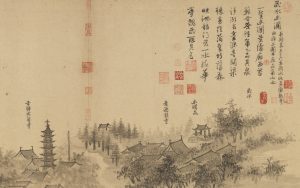Friday, December 1, 4:30 – 6:30 pm, CWAC 156
Traditions Reinterpreted: Text and Image in Wu Zhen’s Eight Views of Jiahe (1344)
Yifan Zou
Department of Art History, University of Chicago
Wu Zhen 吳鎮 (1280-1354), Eight Views of Jiahe 嘉禾八景 , 1344, ink on paper handscroll, 37.5 x 566 cm.
This paper explores the Yuan dynasty (1271-1368) painter Wu Zhen’s 吳鎮 (1280-1354) depiction of his hometown in Eight Views of Jiahe 嘉禾八景 (1344), a 37.5 x 566 cm paper handscroll with ink renderings of eight scenes and accompanying text. Despite several previous excursions into this scroll, I propose still another trip back to the Jiahe. Not only does the “hypnotic effect” of the “eight views” topic encourage a periodic retelling, but due to their different focuses, most previous studies have not examined the work’s text and images as a coherent whole. This paper will explore how different traditions—the tradition of the Eight Views, and the traditional relationship between map and text in Chinese gazetteers, especially Song dynasty tujing 圖經 (cartographic classics)—were reinterpreted in Wu Zhen’s Eight Views of Jiahe. The questions that can be raised from an exploration of this work are broader than might be expected. Could it help us discover how Wu Zhen—a painter who lived most of his life in obscurity—made his way around the territory? In what way did he translate knowledge from tujing to the Jiahe handscroll to make it an appealing fundraising tool for local site? Where can we pin this work on the spectrum from maps to landscape paintings? Finally, how might this work lead us to approach the question of professionalism in the realm of cartography before European cartographic techniques were introduced to China? While it is impossible to resolve these questions, this paper will attempt to contribute to them.
Friday, December 1, 4:30 – 6:30 pm, CWAC 156
Persons with concerns regarding accessibility please contact Nancy P. Lin (nancyplin@uchicago.edu)








